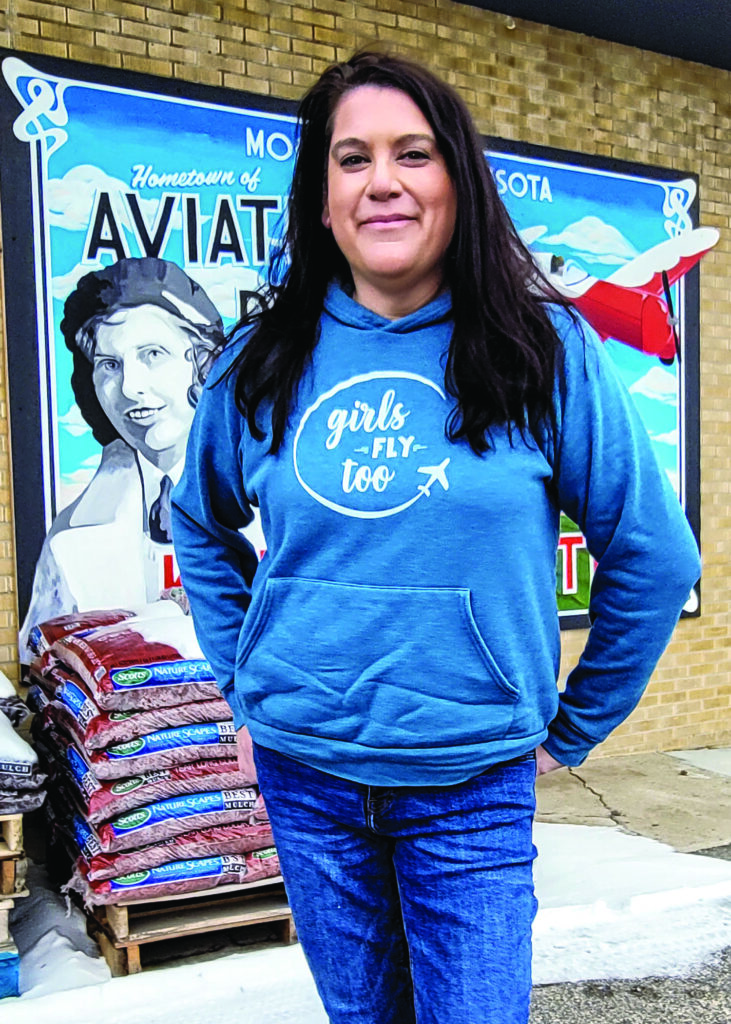
Marisa Bengtson-Loerzel is asking the Moorhead Airport Commission to rename the local field after pioneer aviator Florence Klingensmith. (Photo/Nancy Hanson).
Nancy Edmonds Hanson
A century ago, Moorhead’s pioneer aviatrix Florence Klingensmith about to embark on an epic career in the skies – one that would earn her a principle rank among the earliest women in aviation.
Now, a modern Moorhead woman who shares her passion for piloting has proposed to memorialize the legendary aviatrix at her home town’s flying field.
Marisa Bengtson-Loerzel approached the Moorhead Airport Commission earlier this fall about amending its name. Under her proposal, its formal name would be amended to “Moorhead Municipal Airport – Florence Klingensmith Field.” While the commission took no action at the time, the city is looking for comments from residents. The groundswell of support since the call for comments suggests that the move may be on the agenda of the commission’s next meeting Feb. 23. If approved, a formal request will go to the City Council.
If Marisa’s affection for Klingensmith seems familiar, it’s because this is her second effort to commemorate her idol. Marisa was behind the Art and Culture Commission’s go-ahead to design the mural featuring Florence on the west side of Ace Hardware on Main Aveuue downtown.
“I used to fly back in the 1990s. It’s been my passion since I was a kid growing up in San Francisco,” she explains. “I’d sit at the airport for hours and hours watching planes take off and land.”
Though she has lived here for 20 years, she first learned of the local woman’s link to aviation history when Florence was prominently featured in Keith O’Brien’s best-selling book Fly Girls. After its publication in 2018, it was featured in local libraries’ “One Book, One Community” program, reviving the nearly forgotten story of the girl – remembered as something of a daredevil – who moved from Kragnes to Moorhead in 1918 and graduated from Moorhead High. The book recounts the stories of Florence, Amelia Earhart and three of their contemporaries in their quest to prove that women could fly as fast as any male pilot – maybe better.
Florence fell in love with flying after her first airplane ride at the Interstate Fair in 1921, just 18 years after Wilbur and Orville Wright first got off the ground near Kitty Hawk. She was hooked. By 1928, she was the only woman among 400 men at Hanson Mechanical Trade School in Fargo. Graduating as accomplished mechanic, she got a job at Hector Field, trading her labor for flying lessons. In 1929 she became the first woman to be licensed as a pilot in North Dakota.
But she had no money to buy her own plane. In 1931 she raised funds from publicity-savvy local businessmen to finance her own aircraft. While debate raged over whether women were fit to fly, with their supposed lady hormones and delicate sensibilities, Florence drew crowds across the country as a stunt pilot in air shows, the huge spectacles of the day. She won or placed in a succession of women-only air races, then took second in an otherwise male-only competition.
The climax of her career came in 1933, when she competed against male pilots in the International Air Race during the Chicago World’s Fair. She and the airplane she had souped up herself were in third place … when the fabric ripped on its right wing. That touched off a nosedive into the ground.
Observers said the young pilot could have saved herself by parachuting free. That would have left her plane to sail like an unguided missile, likely to plunge into the crowd or the city below. Instead, she attempted to regain control, riding it to the end, when it buried its nose in a field. She was probably killed on impact.
But rather than being hailed as a heroine, her death was seized upon as proof that women shouldn’t fly. Some questioned whether she might have had her period; women pilots were actually banned for a year after the accident. But after a male pilot was killed in a nearly identical accident, it was finally understood that the aircraft she’d modified to double its horsepower was flawed.
Yet, instead of a hero’s welcome, her body was loaded in a cardboard box and traveled back to Moorhead in a boxcar. “I get emotional, thinking of how she was treated,” Marisa admits. Her simple grave at Oak Mound Cemetery is marked today by a monument designed by members of the Oak Mound 4-H Club.
Marisa has researched the costs associated with the potential airport name change, which requires not only city approval but a nod from the Federal Aviation Administration and Minnesota Department of Transportation. She found that the Faribault airport recently went through the same process on the way to rechristening its field for another woman, WASP pilot Liz Wall Strohfuss. “The airport manager said it really didn’t cost anything, except for the updated sign,” she reports.
For more information and to weigh in on the proposed name change, go to https://www.cityofmoorhead.com/home/showdocument?id=7082. An email link appears on that page, along with letters of support already filed by author Keith O’Brien and the Minnesota Chapter of the Ninety-Nines, the international organization of women pilots founded by Amelia Earhart.


